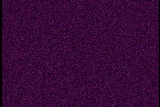
Back جليد بصري Arabic Visual snow Czech Visual-Snow-Syndrom German Vida neĝo EO Nieve visual Spanish سندرم دید برفکی FA Visual snow Finnish Neige visuelle French Sindrome della neve visiva Italian ビジュアルスノウ Japanese
| Visual snow syndrome | |
|---|---|
| Other names | Persistent positive visual phenomenon,[1] visual static, aeropsia |
 | |
| Animated example of visual snow-like noise | |
| Specialty | Neurology, Neuro-ophthalmology |
| Symptoms | Static and auras in vision, Palinopsia, Blue field entoptic phenomenon, Nyctalopia, Tinnitus |
| Complications | Poor quality of vision, Photophobia, Heliophobia, Depersonalization and Derealization[2] |
| Usual onset | Visual Snow can appear at any time, but it commonly appears at birth, late teenage years, and early adulthood. |
| Causes | Unknown,[3] hyperexcitability of neurons and processing problems in the visual cortex[4][5] |
| Risk factors | Migraine sufferer,[6] psychoactive substance use |
| Differential diagnosis | Migraine aura,[7] Persistent aura without infarction, Hallucinogen persisting perception disorder[8][9] |
| Medication | Anticonvulsants[7][3] (limited evidence and success) |
| Frequency | Uncommon (understudied) |
Visual snow syndrome (VSS) is an uncommon neurological condition in which the primary symptom is that affected individuals see persistent flickering white, black, transparent, or colored dots across the whole visual field.[7][4]
Other common symptoms are palinopsia, enhanced entoptic phenomena, photophobia, and tension headaches.[10][11] The condition is typically always present and has no known cure, as viable treatments are still under research.[12] Astigmatism, although not presumed connected to these visual disturbances, is a common comorbidity. Migraines and tinnitus are common comorbidities that are both associated with a more severe presentation of the syndrome.[13]
The cause of the syndrome is unclear.[3] The underlying mechanism is believed to involve excessive excitability of neurons in the right lingual gyrus and left anterior lobe of the cerebellum. Another hypothesis proposes that visual snow syndrome could be a type of thalamocortical dysrhythmia and may involve the thalamic reticular nucleus (TRN). A failure of inhibitory action from the TRN to the thalamus may be the underlying cause for the inability to suppress excitatory sensory information.[4][6] Research has been limited due to issues of case identification, diagnosis, and the limited size of any studied cohort, though the issue of diagnosis is now largely addressed. Initial functional brain imaging research suggests visual snow is a brain disorder.[14]
- ^ Licht, Joseph; Ireland, Kathryn; Kay, Matthew (2016). "Visual Snow: Clinical Correlations and Workup A Case Series". researchgate.net. Larkin Community Hospital. doi:10.13140/RG.2.1.2393.9443. Retrieved 3 September 2017.
- ^ "Diagnostic Criteria | Visual Snow Initiative". 23 March 2023.
- ^ a b c Brodsky, Michael C. (2016). Pediatric Neuro-Ophthalmology. Springer. p. 285. ISBN 9781493933846.
- ^ a b c Bou Ghannam, A; Pelak, VS (March 2017). "Visual snow: a potential cortical hyperexcitability syndrome". Current Treatment Options in Neurology. 19 (3): 9. doi:10.1007/s11940-017-0448-3. PMID 28349350. S2CID 4829787.
- ^ Bou Ghannam, A.; Pelak, V. S. (2017). "Visual Snow: A Potential Cortical Hyperexcitability Syndrome". Current Treatment Options in Neurology. 19 (3): 9. doi:10.1007/s11940-017-0448-3. PMID 28349350. S2CID 4829787.
- ^ a b Cite error: The named reference
VSHEADACHE2014was invoked but never defined (see the help page). - ^ a b c Dodick, David; Silberstein, Stephen D. (2016). Migraine. Oxford University Press. p. 53. ISBN 9780199793617.
- ^ Cite error: The named reference
ReferenceAwas invoked but never defined (see the help page). - ^ Cite error: The named reference
ReferenceBwas invoked but never defined (see the help page). - ^ "Visual snow syndrome - About the Disease - Genetic and Rare Diseases Information Center". rarediseases.info.nih.gov. Retrieved 2022-10-30.
- ^ Puledda, Francesca; Schankin, Christoph; Goadsby, Peter J. (2020-02-11). "Visual snow syndrome: A clinical and phenotypical description of 1,100 cases". Neurology. 94 (6): e564 – e574. doi:10.1212/WNL.0000000000008909. ISSN 0028-3878. PMC 7136068. PMID 31941797.
- ^ Schankin, CJ; Goadsby, PJ (June 2015). "Visual snow--persistent positive visual phenomenon distinct from migraine aura". Current Pain and Headache Reports. 19 (6): 23. doi:10.1007/s11916-015-0497-9. PMID 26021756. S2CID 6770765.
- ^ Puledda, Francesca; Schankin, Christoph; Goadsby, Peter (2020). "Visual snow syndrome. A clinical and phenotypical description of 1,100 cases" (PDF). Neurology. 94 (6): e564 – e574. doi:10.1212/WNL.0000000000008909. PMC 7136068. PMID 31941797.
- ^ Traber, Ghislaine L.; Piccirelli, Marco; Michels, Lars (February 2, 2020). "Visual snow syndrome: a review on diagnosis, pathophysiology, and treatment". Current Opinion in Neurology. 33 (1): 74–78. doi:10.1097/WCO.0000000000000768. ISSN 1350-7540. PMID 31714263 – via NHI.